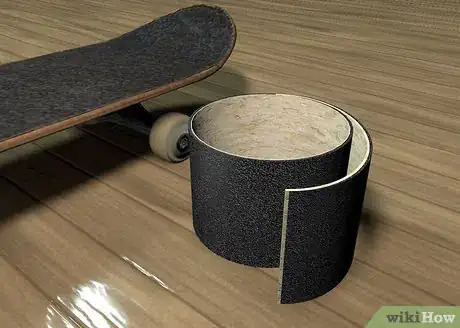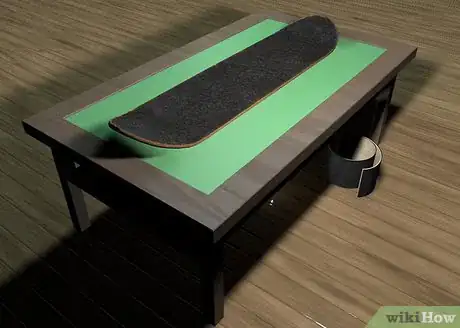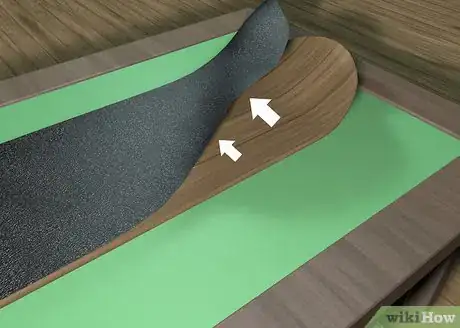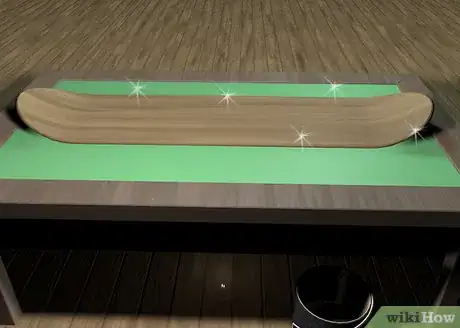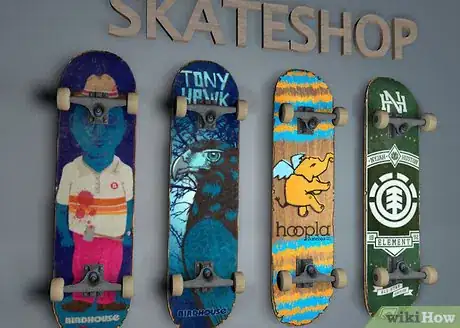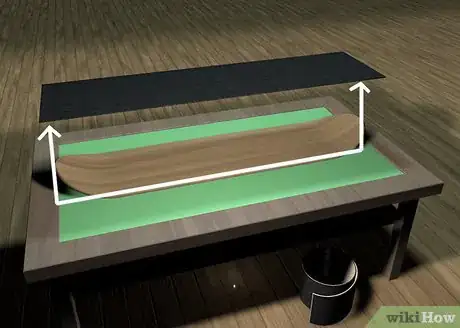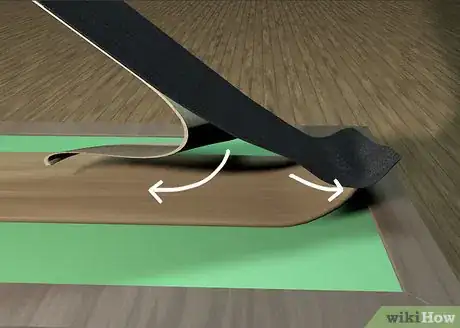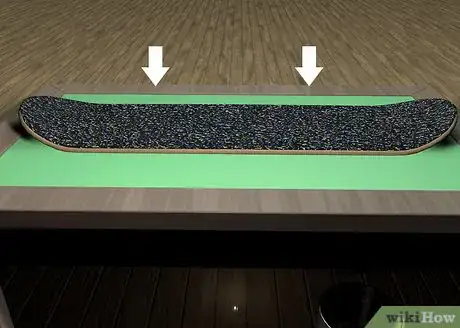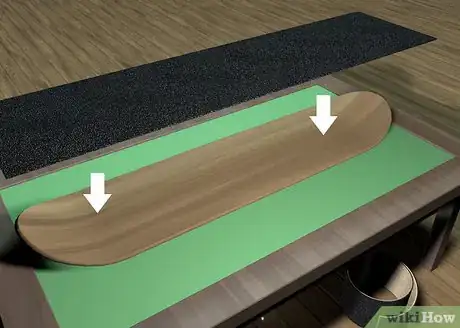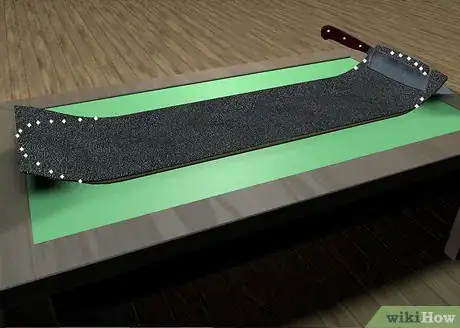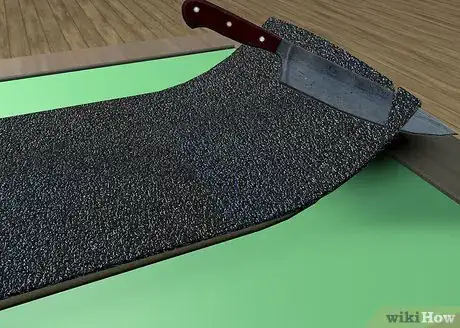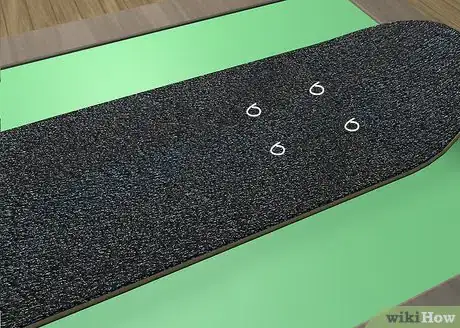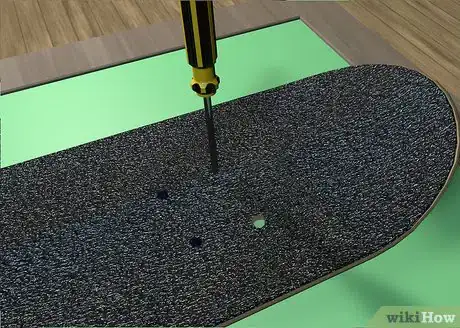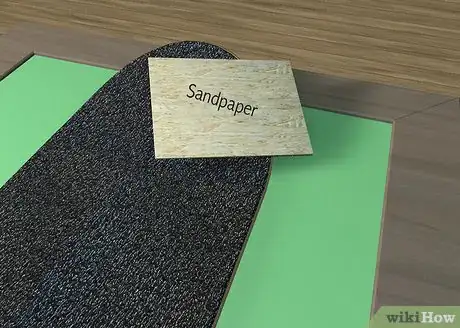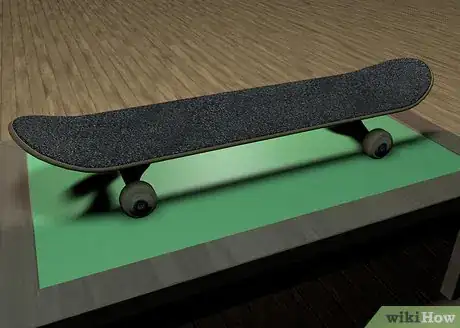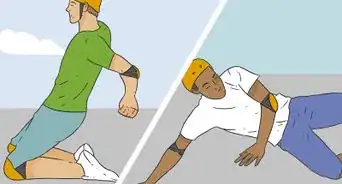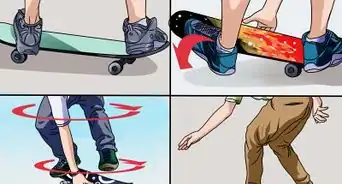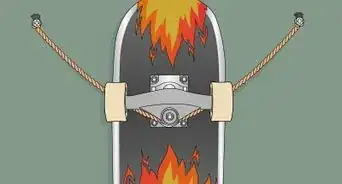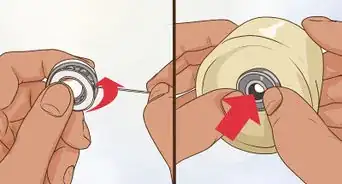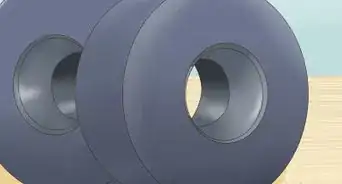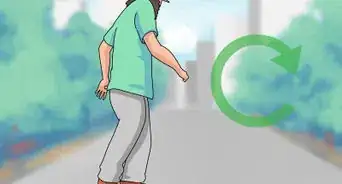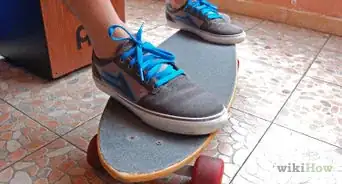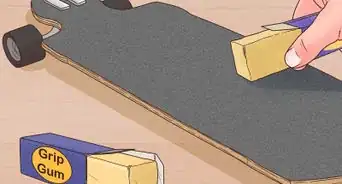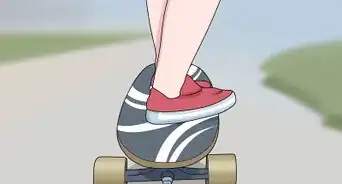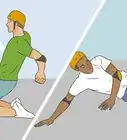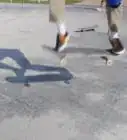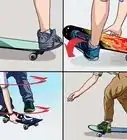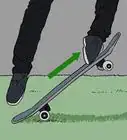wikiHow is a “wiki,” similar to Wikipedia, which means that many of our articles are co-written by multiple authors. To create this article, 23 people, some anonymous, worked to edit and improve it over time.
This article has been viewed 119,037 times.
Learn more...
Griptape is the gritty layer that makes it easier for your shoes to grip a skateboard deck. You can take your board to a skate shop, or you can do the job yourself. Replacing grip tape adds safety and improves your skill, so heavy skaters should consider doing it often!
Steps
Preparing the Board
-
1Buy griptape. Look for brand names that are dedicated to grip tape, such as Alien Ware, Speed Demons, Mob, Black Magic, Grizzly, and Jessup.
-
2Set your skateboard on a flat, clean work surface. This can be the ground, a table, or any other comfortable space.Advertisement
-
3Remove any existing griptape. Peeling off the old tape is simple, but it takes time. Using a hair dryer can help. Pull it slowly and carefully away from the deck. If you are too rough or hasty, the tape may rip and tear, making the job harder.
-
4Clean your skateboard completely. Rid the deck of dust, dirt, rocks—anything that could ruin the tape's adhesive. You'll need it to be as clean as possible, so that your new griptape sticks to your skateboard longer.
-
5Consider taking your board to a skate shop. Many skate shops will put griptape onto your board for you, although it may be cheaper to do it yourself. At the very least, consider visiting a skate shop and asking for help if you are still unsure about the process.
Taping the Board
-
1Center the griptape over your skateboard deck. Start by lining up the tape with the board so that you know the correct length and won't have it stuck on crooked. It's difficult to correct mistakes once it sticks. Make sure the grip surface is longer and wider than your deck—you will cut the excess tape away when you are done. If you have a design on your grip, arrange where you want it to be.
- Some people don't like the "classic" grip, and they go for different ways of gripping. For example: you can cut your grip in half before attaching it so that you have a line of grip-less space across your board, or you can draw a "silhouette"and cut it out so that you have a icon on your board.
- Imagine you have a grip tape that has a drawing/design on the center of it, and you don't want it to be in the center of your board. Just center the drawing where you want it to be (e.g. the nose or the tail). You'll probably have a part of your deck with no grip, but you'll also have a big extra piece of grip hanging off the other side. Cut this piece out and use it to fill the "missing grip area".
-
2Peel back a few inches of the paper guard and place it on one end of the board. Smooth out any small bubbles by pressing and pushing in the direction that you are lining the tape. If there are large bubbles that could eventually create a crease, you will want to pull back on the grip tape extremely carefully to remove these. Make sure that the adhesive doesn't stick to anything else.
- Use two hands! This is a slow and patient process, and you don't want to rip the tape.
-
3Carefully smooth the entire grip onto the deck. Start slowly from one end of board and move your way across, pushing down on the tape so that you remove any air bubbles. Some brands already have small holes in their griptape to reduce the risk of air bubbles, but you should probably flatten the tape just to be safe. Flatten the griptape against the edges of the board.
- You can always pull the grip tape up and try again. Try not to do this more than once or twice, or else the grip tape may lose its sticky backing.
-
4Make sure that the grip is in line with the board. Make sure that the griptape covers the entire surface, unless you are leaving exposed wood in some areas for stylistic reasons. Some of the griptape may extend past the edges of the deck, but do not worry—you will trim this excess away with a knife or razor.
Finishing the Board
-
1Scrape the sides. You'll notice that you have "extra" grip on the edges of the deck. Grab a screwdriver, a metal file, or another blunt object, and scrape it around the sides of the board until the griptape develops a white edge. This is a way of sealing the edges of your griptape. If you do this correctly, you'll have a white outline of your deck on your grip—this outline marks out the area where you should cut away the excess grip tape on the side of your skateboard.
- Make sure to use long strokes instead of short, aggressive ones—otherwise, you might tear up the sides. Also be careful not to file off the polish on the edge of your board.
-
2Use a knife or a box cutter to trim off any excess tape. Most boards have curved edges from sanding, so you want to trim the tape past the curve along the edge. Make long and steady cut motions for the best result. Remember to hold the blade in a slight angle towards the edge of the skateboard so you don't get a small line of grip sticking out. Use the outline of your grip for reference: you need to cut along the sides of the deck, and around the nose and tail of the board.
- Make sure to keep all fingers out of the way at all times, as the razor blade can easily slip from the material.
- Use two hands to make it easier. You do not want it to accidentally dig into the deck of your board!
-
3Flatten out air bubbles. Once the board is completely taped, inspect it for small air bubbles. Use a knife or a razor blade to make small incisions into the grip tape; this should release any bulging air bubbles. Smooth over the incision so that the grip tape sticks smoothly to the deck.
-
4Poke holes to screw the trucks on. If you don't yet have trucks on your board, use a screwdriver to poke eight holes in the griptape where the screws for the trucks will go. If you already have trucks on your board, you can wait to poke these holes until you replace the trucks, or you can poke the holes as follows:
- Take a second deck of the same size with no trucks on and use it as a "guide" for where to poke the holes. Mark the spots with a pencil or poke a small hole. You can now use a razor blade to cut a hole around the screw, big enough to unscrew the trucks. Unscrew each one and put them back so it looks "cleaner".
- If you don't have a second board, try to guess where the holes go. Try "following" the screws and poking using a needle. If you poke the center of the deck, the needle won't go far; if you poke the screw, if will go further and you will know where the hole must go.
-
5Neaten up the edges. Your first attempt might look a little butchered, so go around and trim up the ridges. Run the Stanley knife, box cutter, or razor blade around the outer edge of your skateboard to remove any extra scraps. Most of the imperfections will not be too noticeable as the deck wears over time. Take a small piece of extra grip or sandpaper and lightly rub the edges where the grip sticks to the board. This may prevent the grip from peeling off the board later.
-
6Add any last-minute stylistic touches. While you have the knife out, you can cut a little triangle (or another shape) between the screw-holes on one end of the board. Some skaters do this to more easily identify the nose or tail of their board. Cut out a circle or a hexagon to give your board some special looks and give it interesting riding characteristics. If you want you can use paint markers or colored sharpies to draw designs or patterns on the grip tape. Be creative!
Community Q&A
-
QuestionCan I put grip tape over grip tape?
 Community AnswerNo, the very rough surface won't allow the new tape to stick, causing the new tape to just peel off.
Community AnswerNo, the very rough surface won't allow the new tape to stick, causing the new tape to just peel off. -
QuestionHow do I poke holes for the screws with already put down griptape on my skateboard?
 Community AnswerSimply just turn your board upside down so you can see the holes from the other side. Then, just take a screwdriver and poke the holes into the griptape.
Community AnswerSimply just turn your board upside down so you can see the holes from the other side. Then, just take a screwdriver and poke the holes into the griptape. -
QuestionWhat can I use for grip tape will that be different than black grip tape?
 Community AnswerYou can find colored grip tape or clear grip tape on Amazon, there are a ton of options out now. I personally love the look of the clear grip tape if the wood on your board looks nice.
Community AnswerYou can find colored grip tape or clear grip tape on Amazon, there are a ton of options out now. I personally love the look of the clear grip tape if the wood on your board looks nice.
Warnings
- Be careful when working with sharp objects like knives, box cutters, razor blades, and screwdrivers.⧼thumbs_response⧽
Things You'll Need
- Griptape (brand of your choice)
- A screwdriver or skate tool to scrape the sides (a coin, rock, or other scrape-capable object will suffice here)
- Stanley knife, box cutter, or razor blade
- A skateboard deck
- A flat working space
About This Article
To put griptape on a skateboard, start by taking off any old griptape and thoroughly cleaning your board. Then, center some new griptape over your skateboard deck and peel back the paper guard on the back of the griptape at one end. Then, carefully press the end of the griptape onto your board, making sure there aren't any bubbles. Work your way down your board, peeling back the paper guard as you go, until the deck is completely covered. Finally, trim off the excess tape with a knife or box cutter. To learn how to make holes in griptape for screwing the trucks on, scroll down!
